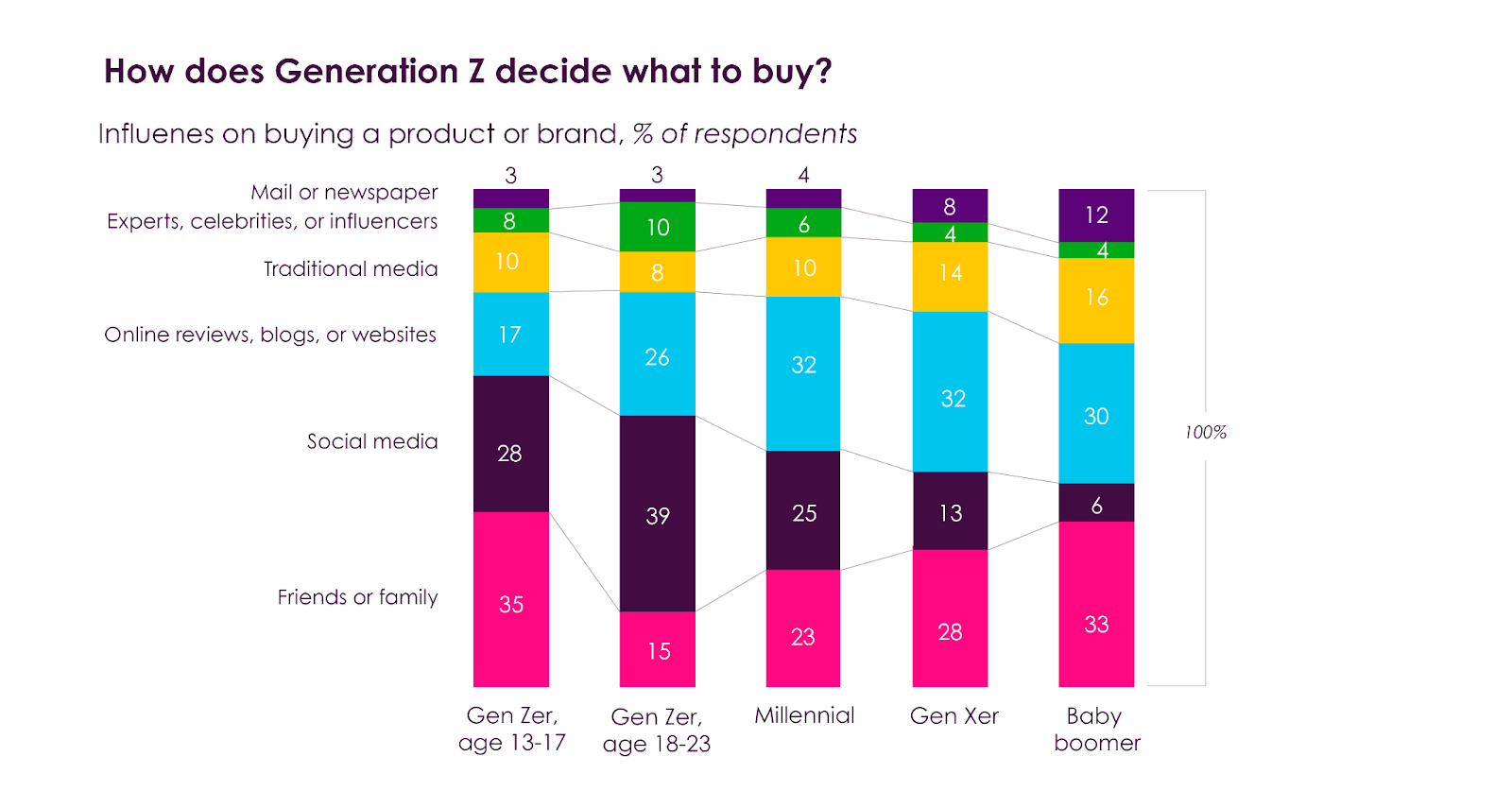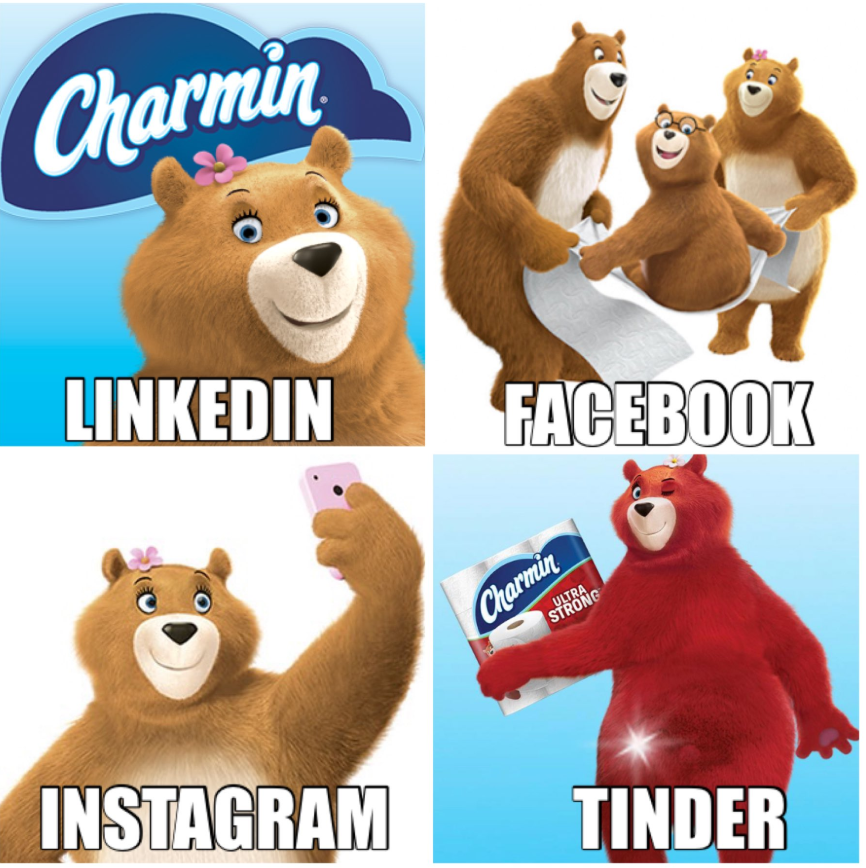As of today, Gen Z’s purchasing power stands at $450 billion.
And by 2030, it’ll expand to a whopping $12 trillion!
In short, the next five years could be critical to your operations.
By 2030, you could either have expanded to unprecedented heights or be pushed out of the market altogether…
And there’s only one thing that stands in the way: an effective Gen Z marketing strategy!
In this blog, I’m going to help you understand the perfect way to reach out to Gen Z and establish a lasting marketing advantage.
Let’s dive in!
How to Market to Gen Z: Table of Contents
- What defines Gen Z as a marketing segment?
- What is the best way to market to Gen Z?
- Best strategies for marketing to Gen Z
- Develop your future-proof Gen Z marketing strategy with LSS
- How to market to Gen Z: FAQs
What defines Gen Z as a marketing segment?
Before we discuss how you can attract Gen Z’ers and convert them to loyal customers for your brand, let’s briefly explore what defines Gen Z as a marketing segment. In my experience, there are five characteristics that set Gen Z apart from the previous generations:
1. Online Purchases
The first distinguishing characteristic of Gen Z is that it has a massive online presence. Having grown up with the internet at their fingertips, this might not come to you as a surprise.
However, I’ve noticed that there’s been a massive shift in their purchasing habits.
For instance, in 2020, around 28% of Gen Zers purchased products online. Today, that figure has doubled to 56%!
In short, if you want to reach Gen Z, you must maintain a state-of-the-art online marketplace. This means creating visually appealing websites and transforming legacy systems into state-of-the-art online ecosystems.
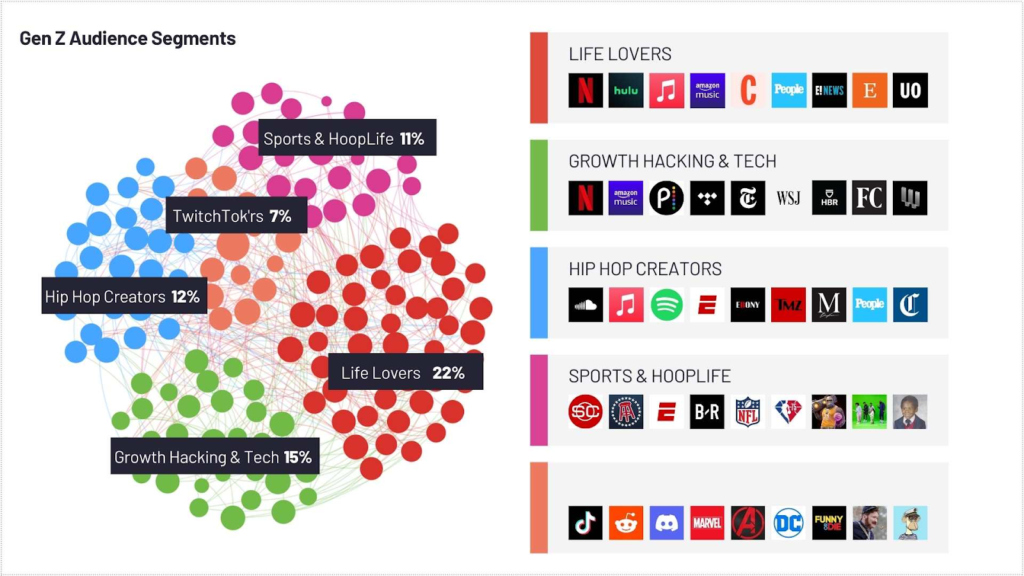
2. Authenticity
If there’s one single thing that defines Gen Z’s buying patterns, it’s authenticity.
Gen Zers don’t just want to buy products and services, they want commodities to convey authenticity.
Whether it’s clothes, pet products, finance or moving services, they prefer commodities that are defined by authentic values.
For example, Gen Z is fine with sacrificing convenience for values. In fact, it’s known for its Boycott Era, wherein it’ll shut out any brand that doesn’t meet basic standards that align with its values.
And there’s a good reason for this: Gen Z isn’t just a consuming generation; it’s also a producing generation. That means almost as many Gen Zers are producers as they are consumers.
The current state of Starbucks is a warning sign: Gen Z has the potential to drive even the biggest brands out of the market, and replace them with more authentic ones!
3. Inspiration
While earlier generations prioritized functionality and convenience when buying products and services, the current generation is looking for something more: inspiration.
The idea isn’t just to fill a gap in the market through a commodity, but to create products that represent a message.
For example, an LA-based brand, Madhappy, has recently entered the market as a clothing brand. However, that’s only a part of what they do. Their strategy has been to offer mental health support to its customers through community events.
Again, I believe there’s a very important reason why inspiration defines Gen Z: they’re exposed to more brands than any other generation. So, the only way to stand out to Gen Z, is to offer it more than your competitors: to make them resonate with your products and the message behind it.
4. Loyalty
Till now, we’ve focused on what we need to offer Gen Z to win its approval and business. As we’ve seen, Gen Z’s motivation goes past just purchasing and transactions.
So, just like it seeks more than just a product, it offers more than just business. It offers the brands who understand them the biggest gift of all: loyalty.
Now, stats suggest that Gen Z is less likely to be loyal to brands than its predecessors. But I believe that we should also account for the number of brands that it has been exposed to. Simply put a lot of brands in the market translate to decreased chances for sustained brand loyalty.
However, if you’re able to create a combination of products and messages that resonate with Gen Z, there’s a huge chance they’ll never abandon you!
5. Community
The traditional marketplace has been defined by individual experiences.
So, even if A had a bad experience, the lack of a public review forum has historically meant that B will not be affected by it.
But all that has changed with the advent of the internet. With review sites like Yelp and social media platforms like X (FKA Twitter) at their fingertips, Gen Zers have a huge platform where they can share and access product reviews.
And this community-driven experience goes both ways!
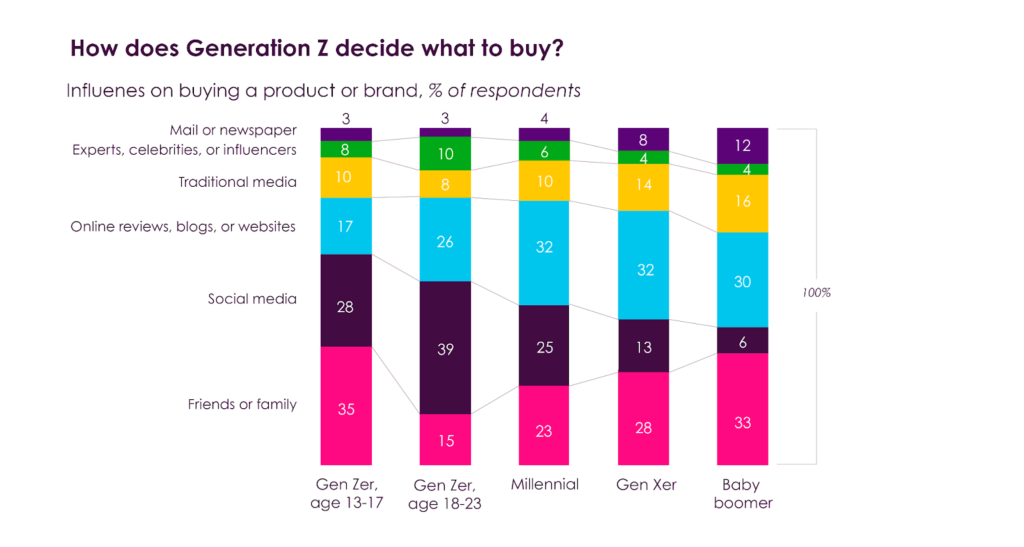
So, if you’re delivering positive experiences, they’re very likely to reverberate through review platforms and social media websites. In short, for better or worse, Gen Z is characterized by an abundance of consumer information!
What is the best way to market to Gen Z?
Okay, so now that we’ve understood what defines Gen Z as a marketing segment, let’s find out what it takes to reach and hold on to them as an audience. In my experience, you need three things to market to Gen Z:
1. Don’t create a campaign, create a story
The first change that we have to make to market to Gen Z has to be in terms of our approach. The idea should not be to create a marketing campaign. Rather, it should be to tell a story involving your product or service.
The oldest example of this is adverts: they tell a story wherein the protagonist solves a problem or overcomes a challenge by using the brand’s product or service.
But here’s the catch: adverts are not even in the top five media categories that Gen Zers rely on to discover new products or services!
Now, the primary solution that the brands have responded with has been social media ads. However, in my opinion, you should not focus on individual ads for specific products.
The goal should be to create brand equity through a common message that unites all your offerings. In short, every product or service should become a part of a cluster of your offerings. And the message you use should center around that cluster.
I think a great example of this is how sports brands like Nike use different products to reinforce the message of authenticity, inclusion and winning through video messages.
2. Experiment with visual content
Speaking of video messages, I think it’s safe to say that visual content is absolutely dominating the market. And Gen Zers are a huge reason behind this.
After all, they use socials like TikTok and Instagram with their multimedia approach to content. Today, even photos can form inspiring stories, let alone reels or short videos!
In short, if you’re looking to cater to Gen Z but are not using visual marketing, you’re probably going to lose to your competitors!
And it’s not just about the negative either. People, and especially Gen Z, are known to be visual learners rather than readers.
So, if you want to market to Gen Z, your best bet is to approach them through conversational short videos that speak to them as individuals!
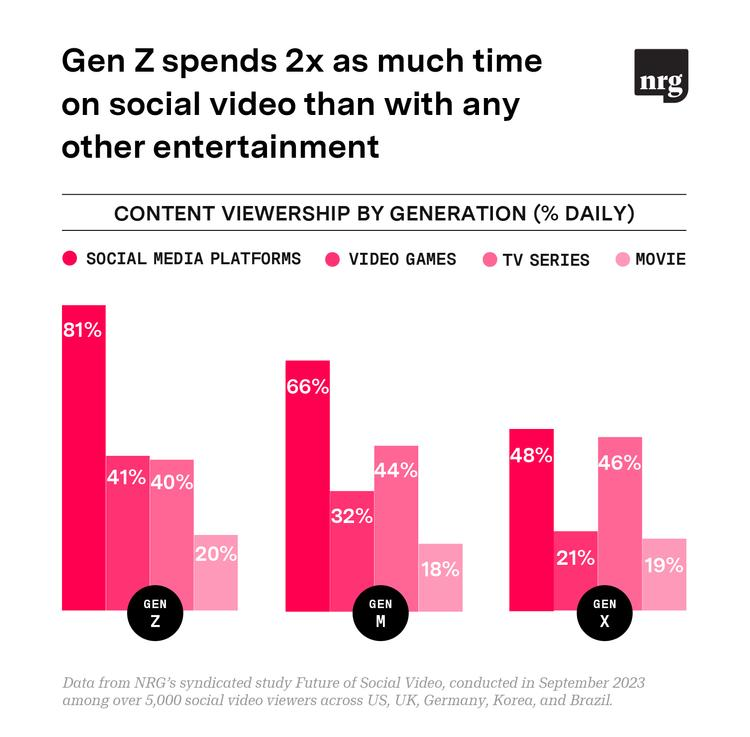
3. Reach Gen Z where it hangs out
The third aspect of marketing to Gen Z is to approach it where it gathers most frequently: social media.
We’ve already discussed that Gen Z doesn’t watch ads but still prefers visual content. And that’s where social media comes in.
The average member of Generation Z spends more than 2.5 hours a day on social media! That’s 2.5 hours every day where you can reach out to them.
The best part is that Gen Z doesn’t mind coming across brands through social media!
With a combination of influencers, well-placed ads, and organic community building, social media is your most powerful tool for Gen Z outreach!
Best Strategies for Marketing to Gen Z
Okay, so if you’re going to launch project Gen Z, you’ll probably need more than just a shift in your approach. You’ll need the best strategies you can use to reach Gen Z and win their trust. Here are the five strategies that I believe have the best chance of getting you there:
1. Deploy Video Content
First, you should focus on creating short video content that Gen Z can engage with. Now, this means more than just product drops or service explainers.
In my experience, it means sharing information about your workspace and production techniques. It means showing Gen Z where your products are made and services developed.
It also means letting Gen Z understand who’s making the products they’re going to use and services they’ll benefit from.
Trust me, the more you open up your operations to Gen Z through video content, the more likely they are to trust your products and services!
Patagonia’s strategy is a great example of this marketing approach. The company stresses the role of sustainability in its products and shares this message with Gen Z through videos on its website and social platforms.
2. Go All-In On Influencer Marketing
If Gen Z is your target audience, it’s time to pivot to influencer marketing. While you might already be a little late to the party, there’s still time to catch up with your competitors.
And there’s a very important reason I’m saying this: brands like Warby Parker, Daniel Wellington, and GymShark have already tasted a lot of success in using influencers to grow their businesses.
Moreover, Gen Zer’s firmly believe that influencers have more power to create trends compared to traditional celebrities. And they point to the influencer’s authenticity as the main reason for their claim.
In my experience, micro and nano influencers, with up to 50K followers, have the greatest ability to influence their followers. I believe this is so because the followers believe that there’s a personal bond between them and the influencer.
My suggestion: start building long-term relationships with micro and nano influencers to win the trust of Gen Z.
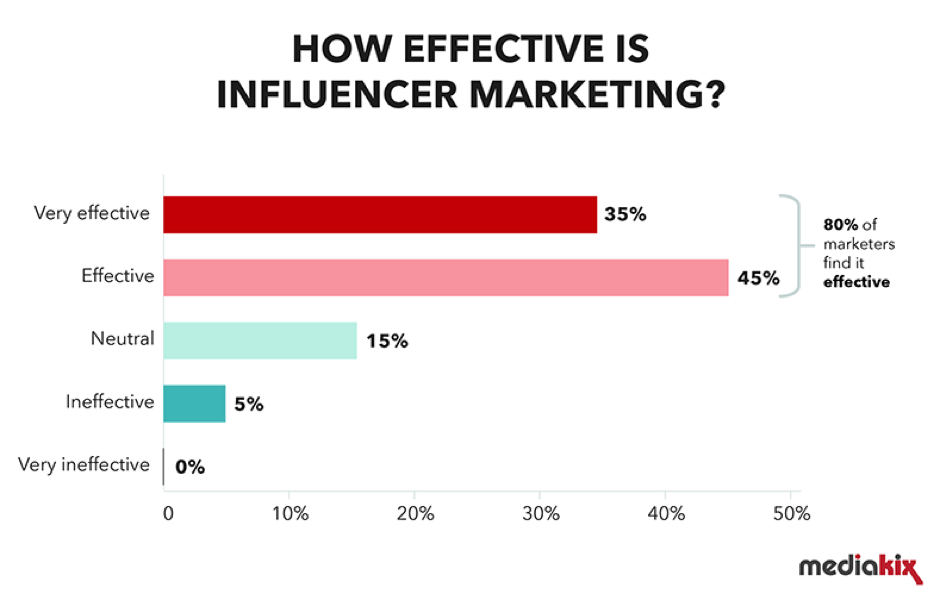
3. Build a Social Community
A social community is a virtual gathering of like-minded individuals. And when it comes to Gen Z marketing, such a community is driven by a brand, a product, or an idea.
A great example of an online community is Apple’s user forum, which probably has an answer to every Mac or iPhone problem that you encounter.
However, as of 2025, the meaning and location of the community have shifted. Today, it’s used to share not just problems and products or services and suggestions, but also concerns or appreciation and offline events or virtual gatherings.
And they can be held anywhere: through AskMeAnything live streams, Twitch sessions, Discord servers, and Meta (FKA Facebook) groups.
In my experience, having a community of users in one place offers you information and access. You can easily ask your users what they like and dislike about your product, and anticipate a marketing trend before it even arises.
Moreover, it also lets your customers believe that they have a voice in your growth: that they’re not alone in their association with you.
And that’s exactly what Gen Z wants: a voice in the business of which they’re patrons!
4. Invest in Experiential Marketing
In 2025, marketing is witnessing another round of revolutions. If video content and social media are two of them, experiential marketing is the third.
Experiential marketing is an evolution of the traditional marketing approach where you let the user try your product or service and then buy it.
And here’s the important part: experiential marketing extends this to more than product or service testing. It aims to include the customer in the company’s growth journey!
This means initiating guerilla marketing initiatives, organizing offline events, and gathering detailed customer reviews.
With experiential marketing, the goal is to immerse the customer into your operations before selling them anything.
And in my opinion, experiential marketing is the best way to sell to Gen Z!
5. Share User-Generated Content
I’ve saved the most important Gen Z marketing strategy for the last.
It’s simple. It’s inexpensive. And it’s a part of experiential marketing.
We know it by the name of User-Generated Content.
If you’ve ever scrolled through a picture with a person holding a personalized Coke can, you probably already know what it is. Or, if you’ve seen Chewy’s social media accounts sharing stories of their users and pets, you’ve already come across UGC.
UGC is an offshoot of experiential marketing, wherein we use Gen Z’s content to tell them about our products. It’s essentially using video peer reviews to attract customers and scale your business.
Personally, I think it’s going to dominate the market like never before in 2025, and even beyond!
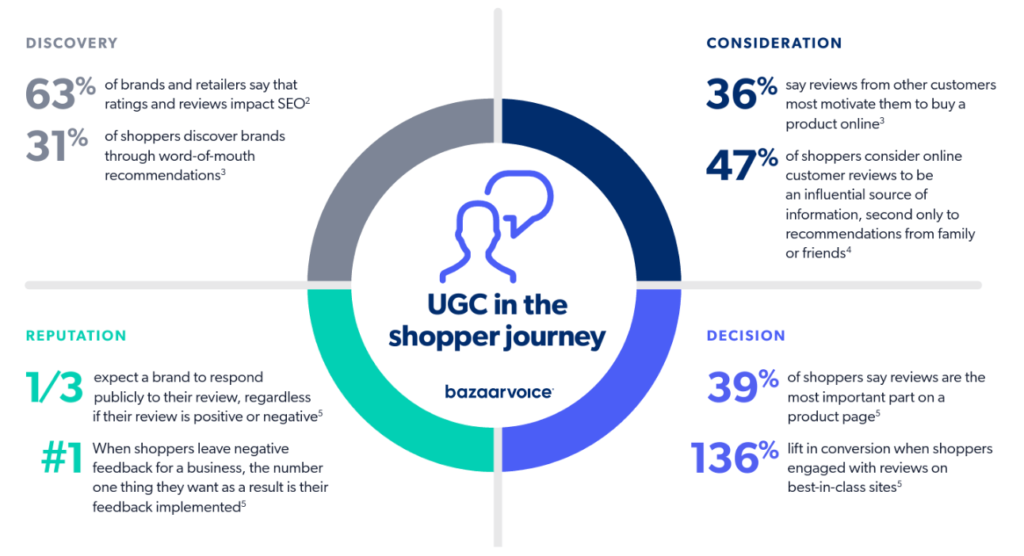
Concert Gen Z Into Your Best Customers…with Lean Summits!
Gen Z is set to change the marketing landscape for at least the foreseeable future.
With trillions of dollars in purchasing power and all the information in front of them, they’re already exhibiting a different buying behavior compared to previous generations.
However, with the right combination of strategies and channels, I strongly believe that you can succeed in capturing and holding Gen Z’s attention for your brand!
From brand equity to experiential marketing, there are several different approaches that you can adopt…however, the key is to strike the right balance between your product/service and Gen Z’s purchasing preferences.
That’s where we come in!
At Lean Summits, we have had massive success in helping a wide range of clients from a diverse range of industries capitalize on the rise of emerging markets.
That’s how we know that we can help you convert Gen Z into your biggest segment through a blend of industry experience and marketing expertise!
Reach out to us for a commitment-free consultation or find out more about our work to discover which marketing approach might suit you best…
Good luck!
How to Market to Gen Z: FAQs
1. What is the Gen Z marketing strategy?
Gen Z marketing strategy is the process of developing an exclusive marketing approach to attract members of Gen Z. By 2030, Gen Z will have more than $12 trillion in spending power, so this could be your best investment to date!
2. What defines Gen Z as a buying group?
In my experience, there are five things that define Gen Z as a buying group:
- The search for authenticity
- The feeling of community
- The pursuit of inspiration
- The commitment of loyalty
- The familiarity with online purchasing
3. Where do Gen Zer’s shop for products and services?
Gen Zer’s prefer shopping online, however, stats suggest that they also do engage in in-store shopping. In my opinion, Gen Z’s slight preference for online shopping and familiarity with the internet means you should develop robust online marketplaces and update legacy websites.
4. How to market to Gen Z in 2025?
In my experience, there are five things you should consider to market to Gen Z in 2025:
- Use interactive video content like reels and shorts
- Build influencer networks to win Gen Z’s trust
- Create communities and organize virtual events
- Adapt to experiential marketing tactics
- Invite your customers to share their experiences through user-generated content
5. How does Gen Z engage with brands?
When it comes to brand engagement, Gen Z is, at the same time, more loyal and independent. In other words, they value principles over transactions, but if you exhibit the values they stand by, they’ll show you loyalty in turn!

